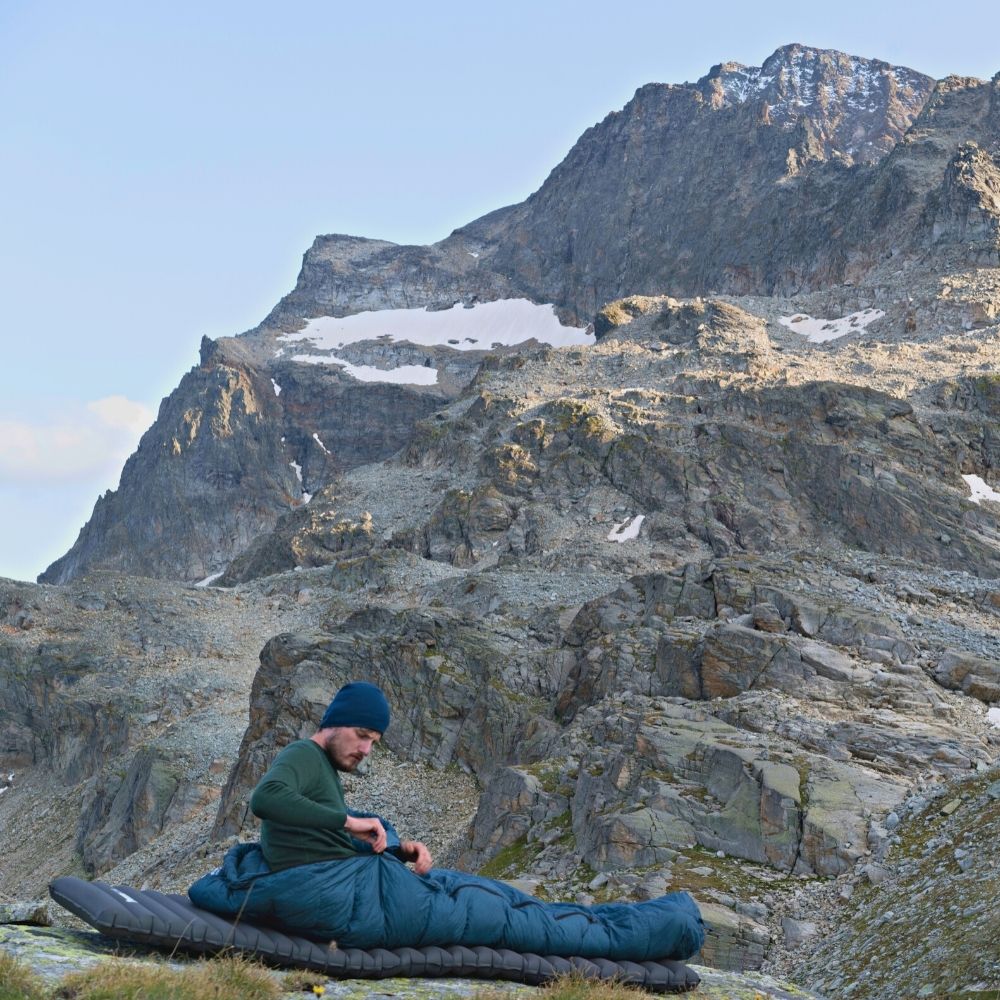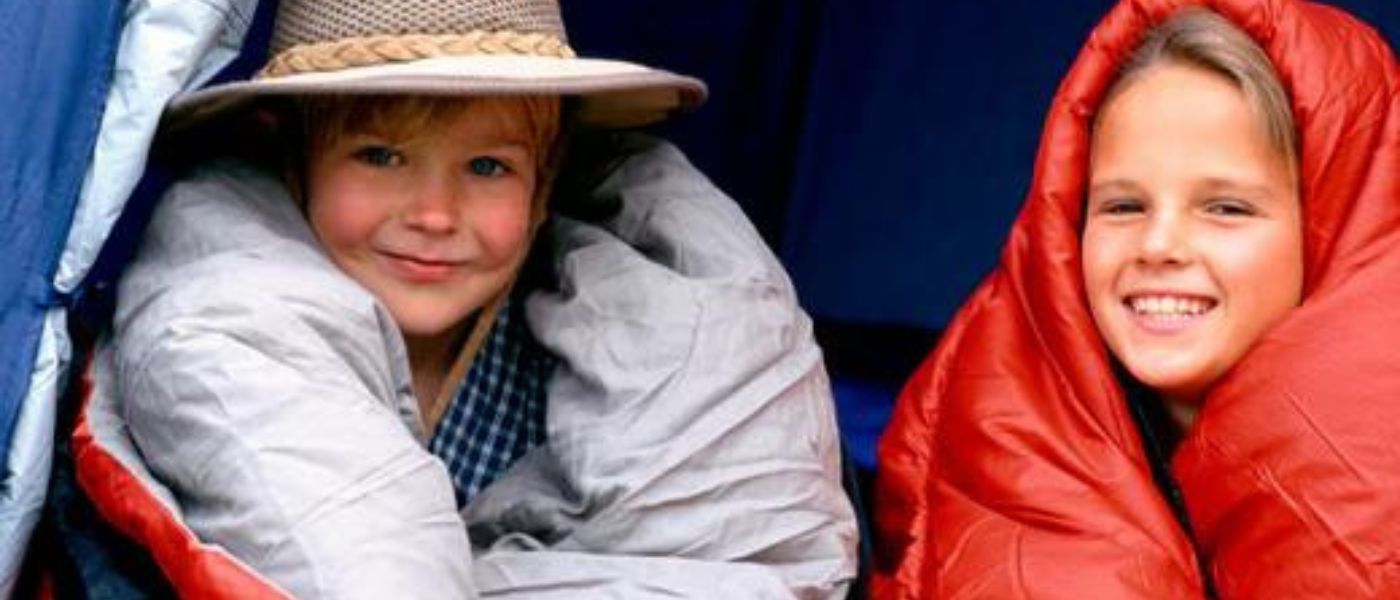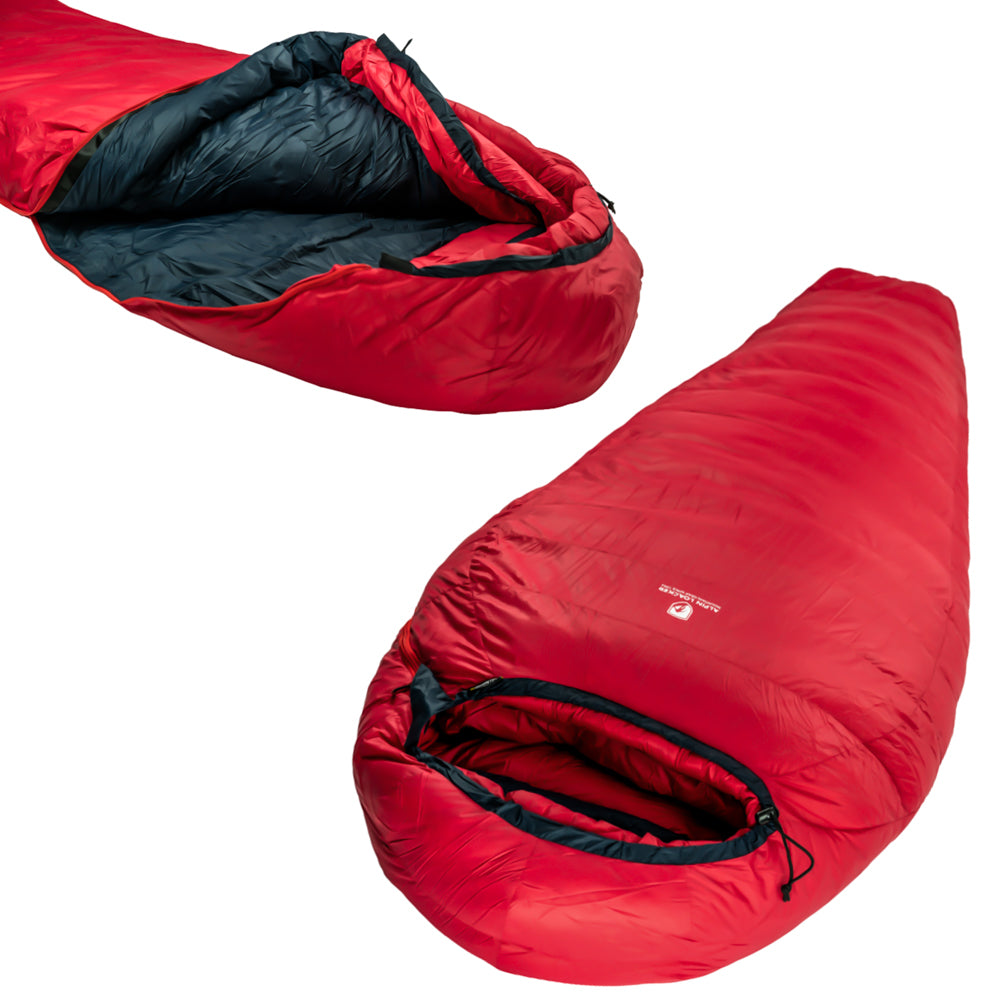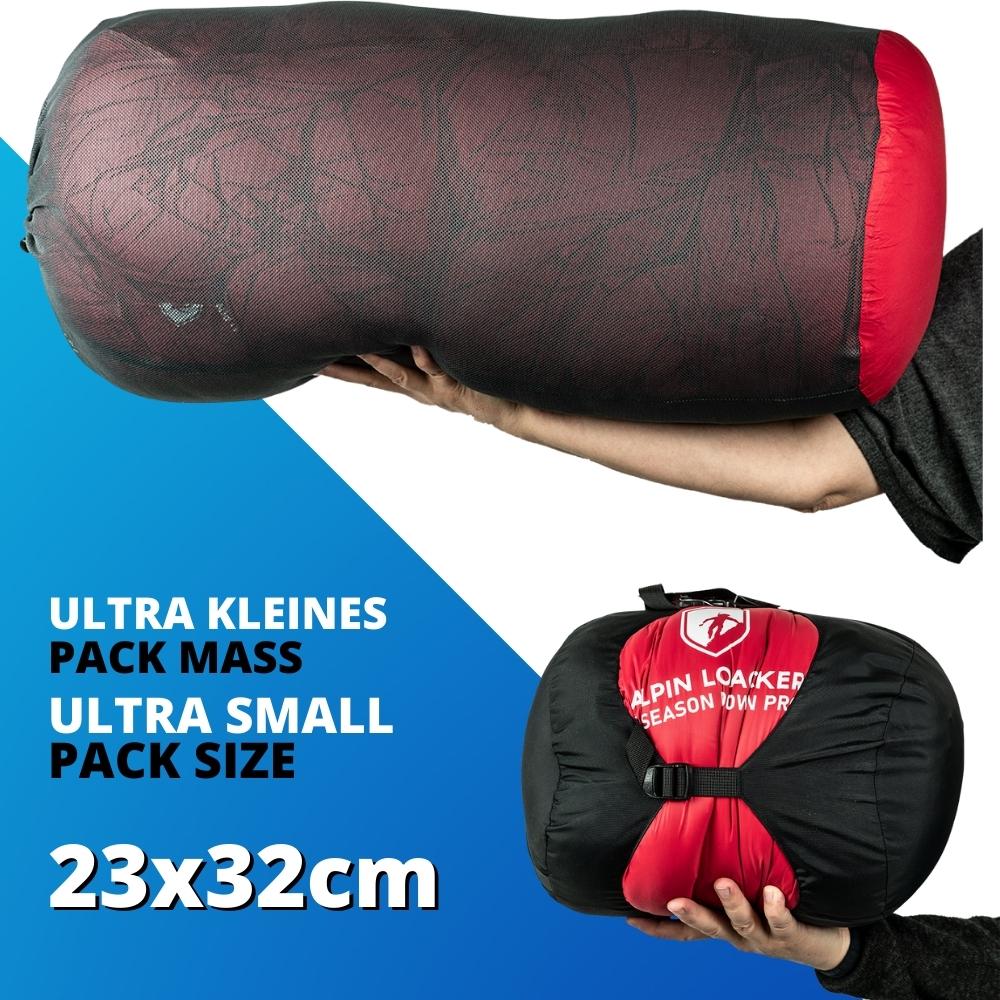Is a 4-season sleeping bag a winter sleeping bag?
In summer, a 4-season sleeping bag is mainly used in higher regions or areas where temperatures can drop significantly even in summer. In summer, the temperature can also drop below 0 in higher mountain regions. If you spend the night on a glacier in summer and have ice underneath you, the question of which sleeping bag to use becomes obsolete - to avoid freezing on this adventure, you absolutely need a warm 4-season sleeping bag and, above all, good insulation from below - i.e. a sleeping mat.
So the answer to the question is yes and no!
Some manufacturers also refer to it as a 5-season sleeping bag. However, this refers to the same model as a 4-season sleeping bag.
What does 4-season sleeping bag mean?
Under certain conditions, a 4-season sleeping bag is suitable for use all year round .
Above all, a year-round sleeping bag must also be usable in winter. This means that
its insulation must be able to cover temperatures from -17°C to +4°C. In other words, the comfort temperature should be around -10 °C. You can find out what is meant by comfort temperature in our blog post: "Winter sleeping bag for outdoor use, help with buying a sleeping bag" to read more.

As the name suggests, the 4-season sleeping bag can be used all year round - under certain conditions.
How long should the zipper of a 4-year-old sleeping bag be?
The 4-season sleeping bag needs both very good insulation and sufficient ventilation so that it doesn't get too warm on warmer nights. The zip of the sleeping bag should therefore be openable up to ¾ of the sleeping bag length if possible or even longer.

The zip of the sleeping bag should be openable up to ¾ of the sleeping bag length if possible.
What else is important when buying a 4-season sleeping bag?
In addition to the temperature specification, it is worth investing time in choosing the right size and shape. The best-known and most common form of all-season sleeping bag is the mummy sleeping bag. It is cut close to the body from top to bottom and has a hood. Some models also have a neck warmer. Due to the close-fitting cut to the body, this sleeping bag retains body heat most efficiently compared to other types of sleeping bag and also has a small pack size.
Other details you should pay attention to when buying are, for example, the chamber construction, the quality and origin of the down and whether the outer material is water-repellent and/or windproof.
If your sleeping bag is connectable, you can zip it to your partner's and the two of you can sleep in it together.

Hood and collar are essential for a 4-season sleeping bag.
Important: The thickest and most insulating sleeping bag will only work if you have a well insulating base. Most of the heat is lost through the ground.
Guidelines and features of good 4-season sleeping bags
- A sleeping bag for four seasons must be able to cover temperatures from approx. +4 °C to approx. -16 °C.
- The shape is adapted to the body: Mummy sleeping bags or egg-shaped sleeping bags.
- Synthetic fiber sleeping bags are for wet and humid climates.
- Low weight
- Down is for dry cold/regions and has a smaller pack size.
- Look out for the designation 4-season sleeping bag or 5-season sleeping bag.
- Small pack size (compression)
- Easy to operate
- Different sizes: Choose a sleeping bag length according to your size.
- Robust upper material
- Sustainable or recycled down

This sleeping bag has a very small pack size. Down can be compressed very well and therefore achieves an even smaller pack size.
Related blog posts

Winter sleeping bag for outdoor use
If you don't want to miss out on outdoor adventures in the cold season, you need a high-quality winter sleeping bag. It protects you reliably from the cold and ensures a restful sleep.
- But how can you recognize a good outdoor sleeping bag for extreme temperatures?
- Is your existing model enough?
All this and much more you will learn in the following blog post. We show you what you pay attention to when buying, tell you about Materials and temperature ranges and show you important life hacks. Sounds exciting? It is! So let's get started.
When do I need a winter sleeping bag?
A warm sleeping bag in the winter is an absolute must-have. That much is certain. But in what other situations do you actually need it?
- Cold winter in the lowlands
- All seasons in the mountains (here it can get very cold even in summer)
- When staying overnight in unheated huts
- If you generally freeze quickly, easily exhausted
- If you suffer from hypothyroidism
- Even extremely lightweight people use a down sleeping bag not only in winter

What is important when buying a winter sleeping bag?
In order for your outdoor sleeping bag to serve you well in the winter, you should before buying the following criteria to consider:
-
Size: A winter sleeping bag for men and women should be chosen neither too big nor too small. It is important that you can stretch out comfortably. However, make sure that there is not too much "air" at the sides, so as not to jeopardize the thermal performance.
-
Shape: For this reason, you should also pay attention to the shape. A mummy sleeping bag is cut close to the body. This gives you much better insulation performance than the egg shape or rectangular blanket sleeping bags.
-
Pack size: Pack size is also crucial. This is one of the reasons why a down sleeping bag is more suitable for winter than other models. You can carry it more easily in your backpack because of the small pack size.
-
Weight: The same goes for the weight. Due to the down filling used, these models weigh less. Our Down Pro 4 seasons down sleeping bag weighs just 1520 g in the 170 cm version. Thus, the winter sleeping bag for men and women is particularly easy to transport.
-
Material: Synthetic fiber sleeping bags are indeed particularly easy to clean and quick drying due to the materials used. However, their thermal performance is very low. Therefore, we recommend you a down sleeping bag for the winter.
Our 4-season down sleeping bag is not only toasty warm, but also breathable and 100% free of harmful substances. The outer material made of 20 D ripstop nylon is, just like the sustainable down filling, absolutely environmentally and skin friendly. So you can enjoy the sleeping comfort you deserve: the best.
- Cost: Especially in this day and age, the cost factor naturally plays an important role. Synthetic fiber sleeping bags are of course cheaper than a natural product like down. But always remember: A warm sleeping bag in winter is more important than other equipment. Especially since you can use a high-quality down sleeping bag for years with good care.
Thus, the acquisition costs are put into perspective. While cheaper models often show extreme heat loss after the second season, our Down Pro 4 keeps you toasty warm for years.
What does the temperature range mean for sleeping bags?
There are up to three different temperature ratingswhichyou can see on the Sleeping bag find:
1. comfort temperature:
This value is calculated for a "norm woman" (25 years, 60 kg, 1.60 m) who is just not cold. As an example: In a sleeping bag with comfort temperature 0° can still sleep comfortably without freezing.
2. limit temperature:
This value shows the temperature at which a "standard man" (25 years, 70 kg, 1.73 m) does not freeze in the sleeping bag.
3. temperature range by season:
- Summer sleeping bags: comfort temperature above 12 °C.
- Three-season sleeping bags: comfort temperature down to 0 °C
- Winter sleeping bags: comfort temperature below 0 °C
Are winter sleeping bags automatically heavier than other models?
"No." It depends largely on the materials processed. Sleeping bags are filled with either synthetic fiber or down.
One Down is a small delicate feather with soft keel and very soft and long arranged feather branches. They are located under the cover feathers of birds. Down is much lighter than synthetic fibers and warms proportionally better than synthetic fibers.
Synthetic fiber needs namely much additional materialtoget to the same comfort range temperature as down.
This means that a sleeping bag filled with synthetic fiber becomes heavier and heavier to achieve the same insulating properties. Thus, a down sleeping bag is often more suitable in winter.

Why is a down sleeping bag best for winter?
As you know Down a special ability. They give you perfect warmth despite their low weight. Therefore, they are ideal for thermal insulation in winter sleeping bags for men and women.
High quality Goose and duck down provide the best thermal insulation in relation to volume and weight. The soft filling is very light, cuddly and highly compressible.
As you have already seen, this results in following advantages:
- Down sleeping bags are not only lighter with the same insulation performance compared to synthetic fiber sleeping bags.
- They are also more compressible and thus have a smaller pack size.
The rule is:
If warmth, weight and pack size play a role, you should only use down sleeping bags.
The sleeping climate in a down sleeping bag is much more comfortable, because the fluffy feathers are very breathable and are also excellent absorb body moisture can. The only disadvantage of down is that it loses its insulating effect when it gets wet. The down collapses and clumps.
However, if you use your down sleeping bag in winter at sub-zero temperatures, you don't have to worry about that. By the way, you should not use down sleeping bags in rain without shelter. The same applies to heavy dew.
You may wonder how you can avoid lump formation in general.
Expert Tip: In winter and any other season, shake out your outdoor sleeping bag thoroughly after getting up and let it dry, preferably hanging in the sun. If there is no sunshine in sight, simply choose a dry place.
Special - sleeping bag comparison:
ALPIN LOACKER Down Pro 4 seasons down sleeping bag & Deuter Astro Pro 1000 down sleeping bag
| Features | ALPIN LOACKER Down Pro 4 | Deuter Astro Pro 1000 |
| Specifications | -10°C | -12°C |
| Comfort temperature | -15°C | -21°C |
| Season | 4 seasons sleeping bag | 4 seasons sleeping bag |
| Weight without storage | 1620 g (195 cm version) L |
1500 g (185 cm |
| Range of use | Trekking, alpine touring | Trekking, alpine touring |
| Material properties | water repellent | water repellent |
| Mixing ratio | 90/10 down/feathers | 90/10 down / feathers |
| Bulking power | 750 cuin | 650+ cuin |
| Filling material | white duck down 1000 g RDS (Responsible Down Standard) | grey duck down 1000 g |
| Pack size | ø 23cm x 32cm | ø 23cm x 42cm |
| PFC free* | yes | yes |
| Main material | 100% recycled 20D ripstop nylon (PA) | 20 D Ripstop PA (polyamide) |
| Featueres | Water repellent down DowntekTM PFC free Hydrophobic down, so the sleeping bag is still warm even when wet | water repellent down DWR Durable Water Repellency PFC free |
| Suitable for | unisex | unisex |
| Construction | Mummy sleeping bag | Mummy sleeping bag |
| Extras | adjustable hood (hood design exactly adapted to the head) compression sack, storage net (when not in use for a longer period of time) | thermal collar, adjustable hood, compression sack, inner pocket, 3D foot box, incl. pack sack |
| Certificates | Responsible Down Standard |
Certified Animal Welfare Green Button Bluesign® Product |
*PFC - What are PFC?
PFC is an abbreviation for per- and polyfluorinated chemicals, - also known as PFAS (per- and polyfluorinated alkyl substances) or PFT (perfluorinated surfactants).
This group of substances comprises more than 3000 different substances. PFCs do not occur naturally. Chemically, the organic compounds consist of carbon chains of different lengths in which the hydrogen atoms are completely (perfluorinated) or partially (polyfluorinated) replaced by fluorine atoms.
PFCs are hardly degradable and therefore remain in the environment for a very long time. Some PFCs accumulate in the environment and in organisms and are also harmful to human health.
Conclusion
At which criteria should you use as a guide when buying your ideal sleeping bag? In principle, it's simple: the sleeping bag that comes with a comfort temperature of zero degrees is the smaller pack size and the smaller weight is the "better" one.
If it also has a robust and water-repellent ripstop nylon, you are on the safe side.
Do you already know the most important care instructions for down sleeping bags? You can find them in our blog post:Washing a Down Sleeping Bag " Tips & Step-by-Step Instructions
FAQ
What should I pay attention to when washing a winter sleeping bag?
No question: a warm sleeping bag in winter is worth its weight in gold. In order to enjoy it for a long time, you should wash your down sleeping bag as little as possible. However, if it needs washing, you should first check it for damage.
At Holes and tears you should not wash a winter sleeping bag for men and women, but first expertly repair first. If no damage is visible, close all closures (except for any lacing) after careful inspection and turn your winter sleeping bag inside out.
A Down sleeping bag may in no case (!) be washed in the washing machine. Here the down clumps and no longer provides any thermal performance.
Instead, soak your winter sleeping bag for adults (and children) rather in hand warm water with a little mild or functional detergent. The bathtub or a large bowl is suitable for this purpose.
Then rinse it under running water and lay it out to dry. Please refrain from wringing and the like. Rather, squeeze out the water carefully so as not to damage the down.
Are there special children's sleeping bags for winter?
Yes, there is not only a suitable winter sleeping bag for adults, but also for children.
What clothes to wear in a winter sleeping bag?
To optimize the thermal performance of your outdoor sleeping bag in winter, you should only use temperature regulating clothing. Cotton and synthetics are completely out of the question.
Our experience has shown that in Merino clothing optimal sleeping comfort enjoys. The natural fiber offers you excellent thermal performance with its thermoregulation ability. In addition, it is odorless, breathable and does not scratch.








